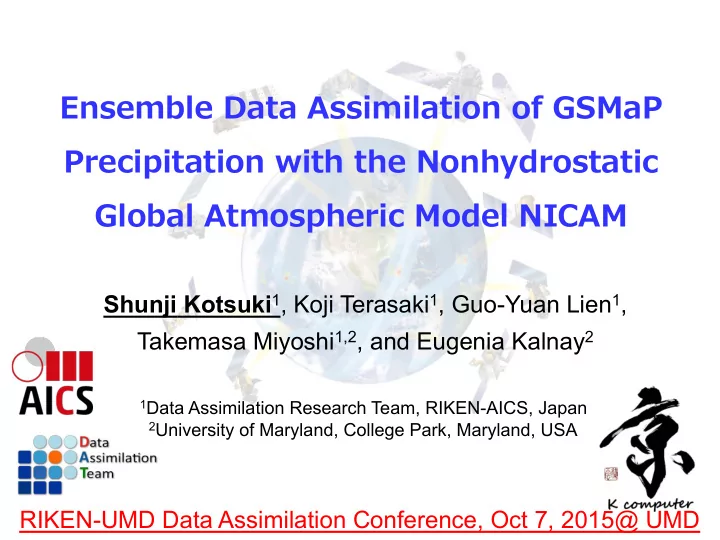

Ensemble ¡Data ¡Assimilation ¡of ¡GSMaP ¡� Precipitation ¡with ¡the ¡Nonhydrostatic ¡� Global ¡Atmospheric ¡Model ¡NICAM Shunji Kotsuki 1 , Koji Terasaki 1 , Guo-Yuan Lien 1 , Takemasa Miyoshi 1,2 , and Eugenia Kalnay 2 1 Data Assimilation Research Team, RIKEN-AICS, Japan 2 University of Maryland, College Park, Maryland, USA RIKEN-UMD Data Assimilation Conference, Oct 7, 2015@ UMD �
Brief self introduction � Shunji Kotsuki • Postdoctoral Researcher • Background – Doctor of Engineering at Kyoto-Univ., Japan (in 2013) – Hydrology & water resources River discharge simulation • Prof. Miyoshi’s Team in RIKEN – from Jan., 2014 – working on • Precipitation DA with NICAM-LETKF • Land data assimilation
Outline � • Introduction • Gaussian-Transformation • DA-cycle experiments • Forecast experiments
Goals � • To improve NWP using satellite-derived precipitation data following Lien et al. (2013, 2015a, 2015b) • To produce a new precipitation product through data assimilation Lien Li en et et al. (2 (2015) ) Radiosondes ONLY � Radiosondes+Precip. (No-Transform) � Radiosondes+Precip. (Log-Transform) � Radiosondes+Precip. Improvement achieved with GFS-LETKF (Gaussian-Transform) � (U-wind @ 500 hPa)
Experimental Setting � • Numerical Model – NICAM (Satoh and Tomita 2004, Satoh et al. 2008, 2014) • GL6 (approx. 110 km resolution) • Observations – PREPBUFR: only upper sounding data (ADPUPA) – GSMaP/Gauge (Ushio et al. 2009) • with Gaussian transformation • Data assimilation – LETKF (Hunt et al. 2007) – NICAM-LETKF (Terasaki et al. 2015) with 36 members • 3D-LETKF • Localization: 400 km for horizontal & 0.4 log(p) for vertical • Relaxation to prior perturbation (Zhang et al. 2004; α = 0.7)
Recommend
More recommend